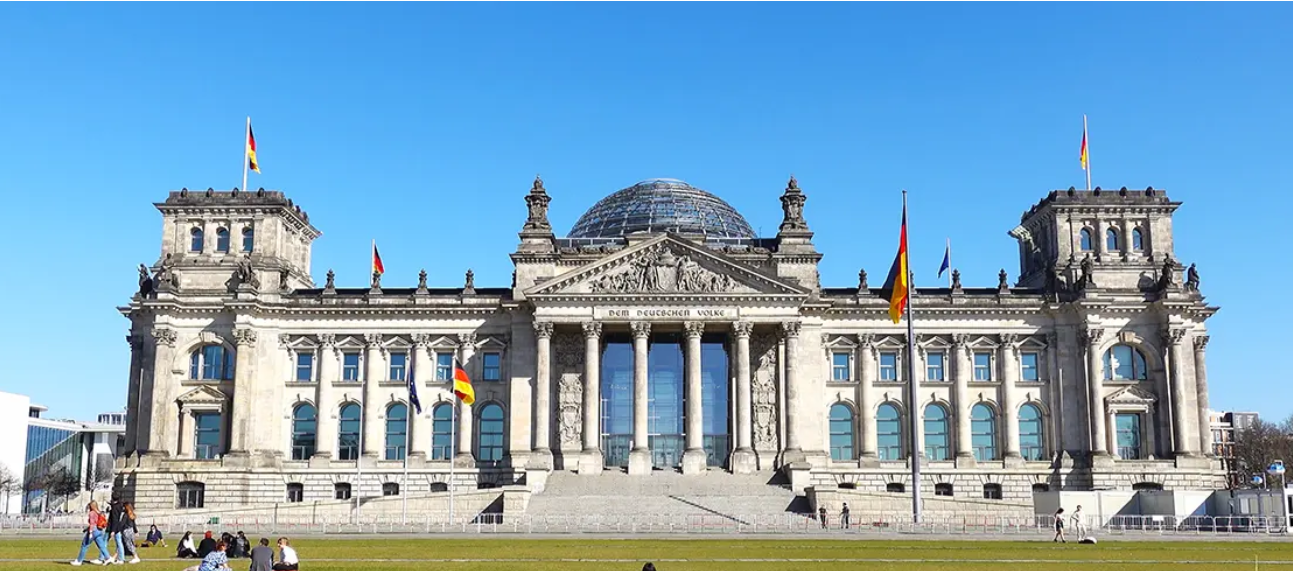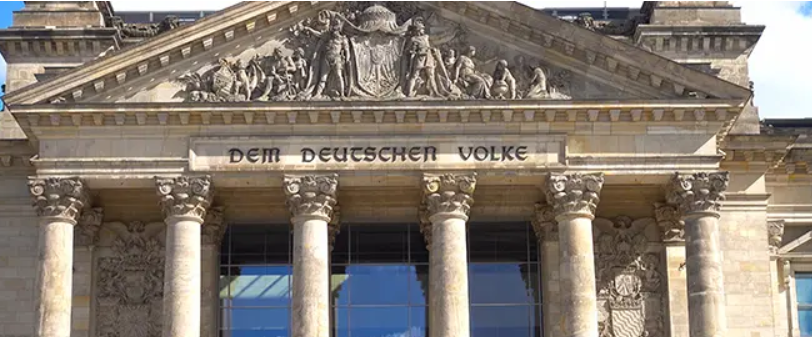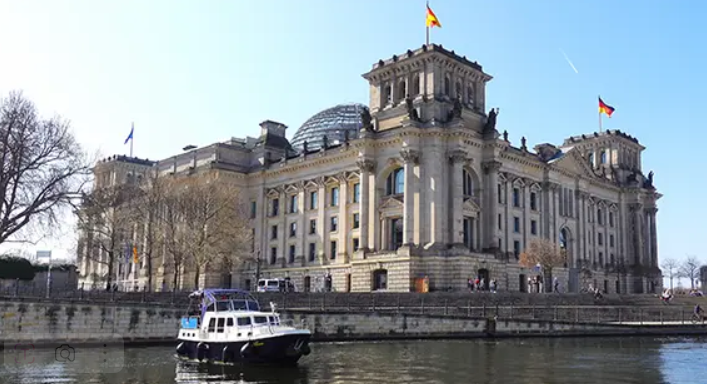Seat of the German Bundestag since 1999
Address: Reichstag Building, Platz der Republik 1, 11011 Berlin | Opened: 1894 | Height: 47 m
The Reichstag building, of course, cannot be missed on any city trip to Berlin. Since its completion in 1894, the building has been and remains a pivotal point for political decision-making. The distinctive architecture that makes this prestigious, monumental building so unique is its combination of Renaissance, Baroque, and Neoclassical elements.
Directions and location of this Berlin landmark
The Reichstag is located in the so-called government district, close to the Spree River and the neighboring district of Berlin Moabit. Berlin Central Station is just a few minutes’ walk away, from where the building’s distinctive dome can be seen.
Those who want to walk to the Reichstag from the main station can cross the Spree River over the Gustav Heinemann Bridge. The walk continues through the green Spreebogen (bend) to Platz der Republik.
Opening Hours and Tours
Depending on what you wish to see in the Reichstag, different opening and tour times apply.
Roof Terrace and Dome of the Reichstag Building – Opening Hours
Daily
from 8:00 a.m. to midnight (last admission: 9:45 p.m.)
Tours are only possible with prior registration (https://www.bundestag.de/besuche). Those interested in stopping by at short notice can register up to two hours in advance, subject to availability, at the Visitor Service’s branch office (SAS) on the south side of Scheidemannstrasse, directly next to the Berlin Pavilion.
Those wishing to visit the roof garden restaurant should reserve a table in advance. Reservations can be made between 10:00 a.m. and 4:00 p.m. by calling +49 30-227-9220. The roof garden restaurant’s opening hours are:
Roof Garden Restaurant – Opening Hours
Monday to Sunday
9:00 AM to 5:00 PM and 7:00 PM to 11:00 PM

Reichstag Admission Prices
A tour of the roof terrace of the Reichstag building and the Reichstag dome are free, meaning there is no admission charge for visiting this monumental building.
Guided Tours of the Berlin Reichstag
Visitors are offered various guided tours of the Reichstag building itself. Advance registration is required to view the building and participate in a guided tour!
FAQ – Frequently Asked Questions about the Reichstag Building in Berlin
When was the Reichstag Building built?
The Reichstag Building was built between 1884 and 1894 to serve as the seat of the German Reichstag. Architect Paul Wallot designed the building in the neo-baroque style, which was later modernized with the addition of Sir Norman Foster’s glass dome.
What is the Reichstag Building?
The Reichstag Building is Germany’s historic parliament building and the seat of the German Bundestag. The building is a symbol of German democracy and a major tourist attraction in Berlin.
How big is the plenary hall in the Reichstag?
The plenary hall in the Berlin Reichstag is 1,200 square meters and has a total of 700 seats.
How heavy and large is the federal eagle?
The so-called “Fat Hen” in the Reichstag’s plenary hall is the Federal Eagle 5. It hangs on the front wall of the plenary hall, weighs 2.5 tons, and has a total area of 58 square meters.
Are there special security measures for visiting the Reichstag building?
Yes, there are special security measures for visiting the Reichstag building. Visitors must register in advance and bring their ID to gain access. In addition, all visitors undergo a security check to ensure the safety of the building.
Berlin Reichstag – Special Features and Interesting Facts
In 1871, Berlin became the capital of the German Reich with the proclamation of the German Empire. The new parliament now needed a seat of government. According to plans by Paul Wallot, the monumental Reichstag building was built between 1884 and 1894, uniquely combining architectural aspects of the Renaissance, Baroque, and Neoclassical periods.
The inscription “To the German People,” added to the gable in 1916, is still in place today. The Reichstag building suffered severe damage during the war, so it was initially unused. Since the dome’s structural stability could no longer ensure its stability, it had to be demolished.
Paul Baumgarten carried out the first renovation work on the Berlin Reichstag building in 1957. The plenary hall was glazed, which pushed the building’s historic character into the background.
In 1990, the German Bundestag moved into the Berlin Reichstag. Nevertheless, the monumental building is still referred to by the same name from the German Empire. The first session of the all-German parliament, consisting of the People’s Chamber and the Bundestag, took place in the plenary hall on October 4, 1990.
The first constituent session of the all-German Bundestag was held three months later in the Reichstag building. On July 20, 1991, a vote decided that Berlin would be the future seat of government.
During the second construction phase, which began in 1994, the glass dome was built, among other things, based on designs by British architect Sir Norman Foster. The steel and glass dome weighs 800 tons. It has a diameter of 40 meters and a remarkable height of 23.5 meters.
Visitors can access the observation deck from the roof terrace via two spiral-shaped pathways inside. The renovation work on the Reichstag building was completed on April 19, 1999, with the first session of the Bundestag, which was held in the remodeled Reichstag.

Historical Facts and History of the Berlin Reichstag
The Berlin Reichstag was at the center of the revolutionary events of 1918. After the German Kaiser abdicated, the republic was proclaimed from a window of the Reichstag building on November 9, 1918, by the Social Democrat Philipp Scheidemann. Berlin Soldiers’ and Workers’ Councils were meeting in the plenary hall at the time.
Parliamentarians did not return to the Reichstag building until 1919. There is a close connection between the fate of the Reichstag and the founding and end of the Weimar Republic. A fire, probably started by van der Lubbe, a Dutch communist and anarchist, destroyed the plenary hall on the night of February 27-28, 1933.
The Berlin Reichstag was once again at the center of the Second World War, when the final battle for Berlin was fought. Because the building held great symbolic value for the Red Army, the goal was to conquer it.
Today’s Reichstag, as it stands in the government district, is a monumental building that impressively combines tradition and modernity. Sir Norman Foster contributed to this with the architecture of the glass dome. This created various perspectives that allow visitors to look across the building.
Visitors can thus look from the western side of the building to the eastern side, let their gaze wander over several floors, or gaze from the dome into the plenary hall.
The glass dome is an architectural masterpiece, not only because Foster created large, light-filled spaces within a monumental building. Rather, the special dome architecture has given the Reichstag a great deal of lightness and transparency, which blends uniquely with the historic structure.
The open design gives Reichstag visitors the opportunity to gain a unique insight into the work of the parliament from the visitors’ level.

Sights and attractions in the immediate vicinity of the Reichstag
If you want to visit the Reichstag, you should also explore the government district and its other buildings. This is easily possible on foot.
Bellevue Palace and the Federal Chancellery with their impressive architecture are worth seeing.
Not far from the government district and the Reichstag building are the Tiergarten park, Museum Island, and Berlin Cathedral.
If you walk from the Reichstag towards Berlin Central Station, you will pass through the verdant Spreebogenpark. Most of the park consists of green areas that rise towards the center. The lawn is intersected by the “Landscape Window,” an art object made of rusted steel and offering views of the buildings at Potsdamer Platz.
The Spree River banks feature themed gardens featuring a diverse range of flowers and meadow grasses.
The riverside promenade is also impressive, connected to the Spreebogenpark’s panoramic path by numerous steps and sloping platforms. A beautiful place to reflect on your visit to the Reichstag.
The Jacob Kaiser House, just a short walk from the Reichstag building, offers a striking contrast and showcases modern architecture.
It’s generally worth strolling through Berlin with your eyes open, because in addition to the sculptures and monuments in Berlin-Mitte, there’s also unique street art to admire on numerous corners.
Cafés and Restaurants Near Reichstag
If you don’t want to have breakfast or dinner at the Reichstag’s rooftop restaurant, you’ll find numerous cafés and restaurants nearby, offering their guests coffee, tea, cake, a cold beer, and delicious meals.
HABEL am Reichstag
Located right next to the Reichstag, HABEL on Luisenstraße offers its guests regional dishes with a subtle Mediterranean touch in its quaint brick vaulted ceiling. German wines are served, and a delicious coffee after the meal perfectly rounds off the experience.
Address: HABEL am Reichstag, Luisenstraße 19
The Berlin Pavilion am Reichstag is located on Scheidemannstraße, and its large windows offer guests a fantastic view of the Reichstag. During the summer months, the terrace is also open, where guests can enjoy schnitzel, spaghetti, and other dishes, coffee, or a cold beer.
Address: Berlin Pavilion at the Reichstag, Scheidemannstraße 1